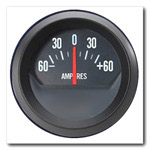 Direct Current Theory 101 Direct Current Theory 101
ELECTRICITY is defined as the flow of electrons through a conductor. Those electrons are small parts of atoms and a conductor is anything that permits this transfer. Most metals are good conductors. DC or direct current, the type used in your car or truck, is where those electrons flow in only one direction, like a one-way street. DC current is really very easy to understand if you think of the flow of electrons as a flow of water, and relate to the three important aspects of amperage, voltage and resistance.
AMPERAGE is the volume of electrons, also called current flow, and is measured in AMPS. Using the water analogy, this would be the same as gallons per hour. AMPERAGE IS VOLUME.
VOLTAGE is the pressure behind those electrons, measured in VOLTS. It would be pounds per square inch (PSI) in the water analogy. The working voltage in most cars today is 13-15 volts. VOLTAGE IS PRESSURE.
RESISTANCE is just that, anything that impedes or restricts the flow. Like a clogged pipe or partially closed valve would restrict the flow of water. Resistance is measure in OHMS. But beware; you cannot use your trusty ohmmeter to measure a bad connection on your car because that little meter simply does not pass enough current. Like the clogged pipe, it will not show a problem until a high volume of AMPS is passed through.
Once you understand what amperage, voltage and resistance are, you need to know their relationship to one another, which is a constant (that means it never changes), OHM'S LAW or E=IxR. It means that VOLTAGE is always equal to AMPERAGE times RESISTISTANCE. Remember that each affects the other two and any electrical problem you encounter on your car is ruled by OHM'S LAW.
When you add resistance to any circuit, especially those involving high current flow, like your charging and starting systems, you LOWER the amount of current that can flow and greatly reduce the ability of the alternator and starter to do their job. Resistance can come from corroded, dirty or loose connections; too small a size wire or cable; worn switch or relay contacts; or even bad connections in the wiring harness itself. Resistance is the number one cause of all automotive electrical problems, in one form or another.
|